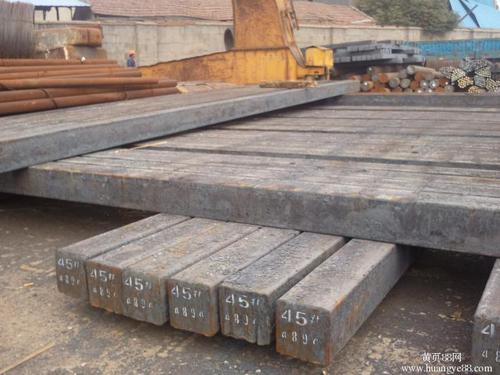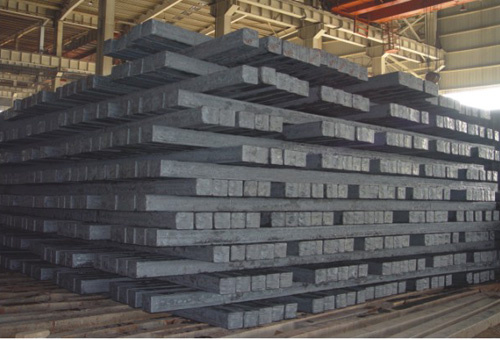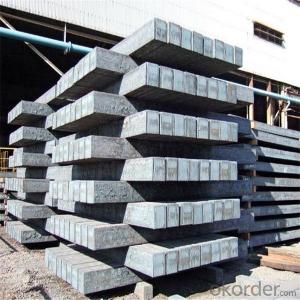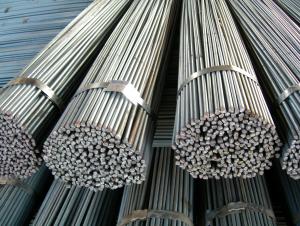Steel Billet High Quality Hot Rolled Q195 Q235 120-150MM
- Loading Port:
- China Main Port
- Payment Terms:
- TT or LC
- Min Order Qty:
- -
- Supply Capability:
- -
OKorder Service Pledge
OKorder Financial Service
You Might Also Like
Product Description:
OKorder is offering Steel Billet High Quality Hot Rolled Q195 Q235 120-150MM at great prices with worldwide shipping. Our supplier is a world-class manufacturer of steel, with our products utilized the world over. OKorder annually supplies products to European, North American and Asian markets. We provide quotations within 24 hours of receiving an inquiry and guarantee competitive prices.
Product Applications:
1) Suitable for making various strong cutting tool abrasion resistance, impact resistance.
2) Used to produce all kinds of high hard and super hard saw blade, drill, tap, broach, gear hob and various kinds of milling cutter.
3) Used for advanced punching die, screw die, and the toughness and complicated shape of the punch, etc.
4) Is used for cold forging die and drawing mode, etc.
5) Recommended watchcase factory, screw factory and other cold stamping products industry use.
Product Advantages:
OKorder's Steel Billet High Quality Hot Rolled Q195 Q235 120-150MM are durable, strong, and resist corrosion.
Main Product Features:
· Premium quality
· Prompt delivery & seaworthy packing (30 days after receiving deposit)
· Corrosion resistance
· Can be recycled and reused
· Mill test certification
· Professional Service
· Competitive pricing
Product Specifications:
1. Grade: GB, JIS, ASTM, EN
2. Grade: Q235, SS400, A36, S235JR
3. Diameter and mass: As below
Diameter | Mass | Diameter | Mass | Diameter | Mass |
(mm) | (kg/m) | (mm) | (kg/m) | (mm) | (kg/m) |
6 | 0.22 | 22 | 2.98 | 53 | 17.30 |
7 | 0.30 | 24 | 3.55 | 56 | 19.30 |
8 | 0.40 | 25 | 3.85 | 60 | 22.20 |
9 | 0.50 | 26 | 4.17 | 63 | 24.50 |
10 | 0.62 | 28 | 4.83 | 65 | 26.00 |
11 | 0.75 | 30 | 5.55 | 70 | 30.20 |
12 | 0.89 | 32 | 6.31 | 75 | 34.70 |
13 | 1.04 | 34 | 7.13 | 80 | 39.50 |
14 | 1.21 | 36 | 7.99 | 85 | 44.50 |
15 | 1.39 | 38 | 8.90 | 90 | 49.90 |
16 | 1.58 | 40 | 9.86 | 95 | 55.60 |
17 | 1.78 | 42 | 10.90 | 100 | 61.70 |
18 | 2.00 | 45 | 12.50 | 120 | 88.85 |
19 | 2.23 | 48 | 14.20 | 140 | 120.93 |
20 | 2.47 | 50 | 15.40 | 150 | 138.82 |
4. Material: Mild Steel
5. Heat treatment of high quality steel:
Fire: Isothermal annealing temperature is 800 ~ 880 °C, with 10 ~ 20 °C, the furnace cooling to about 600 °C, hardness above HB269.
Preheat temperature: 730-730 °C
Quenching temperature: 1190-1210 °C
Tempering temperature: 540-595 °C
Cold drawn, hardness 285 HBS
Cold drawn after annealing condition, hardness 277 HBS
Quenching methods: oil quenching, air cooling or salt bath quenching
FAQ:
Q1: Why buy Materials & Equipment from OKorder.com?
A1: All products offered byOKorder.com are carefully selected from China's most reliable manufacturing enterprises. Through its ISO certifications, OKorder.com adheres to the highest standards and a commitment to supply chain safety and customer satisfaction.
Q2: How do we guarantee the quality of our products?
A2: We have established an advanced quality management system which conducts strict quality tests at every step, from raw materials to the final product. At the same time, we provide extensive follow-up service assurances as required.
Q3: How soon can we receive the product after purchase?
A3: Within three days of placing an order, we will begin production. The specific shipping date is dependent upon international and government factors, but is typically 7 to 10 workdays.
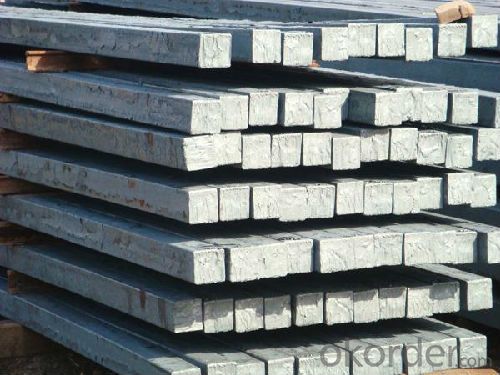
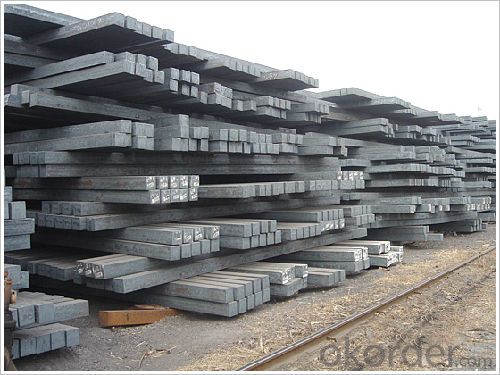
- Q: What are the main types of steel billet rolling mills?
- There are several main types of steel billet rolling mills, each with its unique characteristics and functionalities. These mills are designed to process steel billets into various shapes and sizes, catering to the diverse requirements of different industries. 1. Two-high rolling mills: This type of rolling mill consists of two horizontally mounted rolls that rotate in opposite directions. Two-high mills are commonly used for shaping and reducing the thickness of steel billets. They are relatively simple in design and are suitable for light to medium-duty applications. 2. Three-high rolling mills: Three-high mills have three rolls arranged vertically in a triangular configuration. The upper and lower rolls are driven, while the middle roll is idle and adjustable. This design allows for greater flexibility in shaping and reducing the billet's dimensions. Three-high mills are commonly used for producing high-quality finished products with precise dimensions and surface finish. 3. Four-high rolling mills: Four-high mills have four rolls, two small diameter work rolls and two larger diameter backup rolls. The work rolls are driven, while the backup rolls provide support and adjust the billet's thickness. Four-high mills are highly versatile and can be used for a wide range of applications, including both hot and cold rolling processes. 4. Cluster mills: Cluster mills consist of multiple small-diameter rolls arranged in a cluster. These rolls work together to reduce the billet's thickness and shape it into the desired form. Cluster mills are commonly used for producing high-precision products, such as wires and thin strips. 5. Steckel mills: Steckel mills are specialized rolling mills designed for the production of heavy-gauge plates and strips. They consist of a combination of a reversible rolling mill and a continuous casting machine. Steckel mills are known for their high productivity and the ability to produce a wide range of steel products with excellent surface quality. Each type of steel billet rolling mill has its advantages and is suitable for specific applications. The choice of mill depends on factors such as the desired final product, required dimensions, production volume, and budget constraints.
- Q: How are steel billets used in the manufacturing of shafts?
- Shafts are manufactured using steel billets, which are essential components. These billets are semi-finished steel products that typically have a square or rectangular shape. They are created by pouring molten steel into molds and allowing it to solidify. When it comes to shaft manufacturing, steel billets act as the starting material. They are heated to a specific temperature to increase their malleability and ease of handling. Once heated, the billets undergo various processes like forging, rolling, or extrusion. Forging involves shaping the heated billet using a hammer or press to apply compressive forces. This process enhances the grain structure of the steel, improving its strength and minimizing internal defects. On the other hand, rolling involves passing the billet through a series of rollers to gradually shape it into the desired form. It is commonly used for producing long, cylindrical shafts. Extrusion is another technique employed in shaft manufacturing. Here, the heated billet is forced through a die under high pressure, resulting in a shaft with a specific cross-sectional shape. This method is particularly useful for creating shafts with intricate details or complex geometries. After the initial shaping process, the shafts undergo further steps like machining, heat treatment, and finishing. Machining involves removing excess material and creating specific features such as keyways or threads. Heat treatment is used to enhance the shaft's strength, hardness, and durability. In conclusion, steel billets are the raw materials used in the production of shafts. Through processes like forging, rolling, or extrusion, the billets are transformed into the desired shape, size, and properties of the shafts. This ensures that the resulting shafts are strong, reliable, and suitable for their intended applications in industries like automotive, aerospace, and machinery.
- Q: How are steel billets used in the manufacturing of marine equipment?
- Steel billets are an essential component in the manufacturing of marine equipment due to their unique properties and versatility. These billets, which are semi-finished steel products in a rectangular or square cross-section, play a crucial role in the production of various marine equipment such as ship hulls, propellers, offshore platforms, and marine engines. Firstly, steel billets are used in the construction of ship hulls. The high strength and durability of steel make it an ideal material for withstanding the harsh marine environment, including corrosion, extreme temperatures, and pressure. These billets are forged and shaped into plates, sections, and profiles, which are then welded together to form the hull structure. The use of steel billets ensures that the ship is robust, capable of carrying heavy loads, and resistant to the corrosive effects of seawater. Furthermore, steel billets are utilized in the manufacturing of propellers, one of the most critical components of marine equipment. Propellers are responsible for generating thrust and enabling the movement of ships and boats through the water. Steel billets are forged and machined to create the propeller blades, ensuring they possess the required strength, hardness, and hydrodynamic properties necessary for efficient propulsion. In addition, steel billets are crucial in the construction of offshore platforms used in oil and gas exploration and production. These platforms, which can be fixed or floating, require a robust and stable structure to withstand the harsh marine conditions. Steel billets are used to fabricate the columns, braces, and beams that provide the necessary strength and stability to these platforms. The high load-bearing capacity and corrosion resistance of steel make it an ideal choice for such applications. Lastly, steel billets are employed in the manufacturing of marine engines, which power various vessels. These billets are forged and machined to create the engine components such as crankshafts, connecting rods, and cylinder blocks. Steel's excellent mechanical properties, including high tensile strength, toughness, and wear resistance, ensure that the marine engines can operate reliably and efficiently under demanding conditions. In conclusion, steel billets are indispensable in the manufacturing of marine equipment. They provide the strength, durability, and corrosion resistance required to withstand the harsh marine environment. Whether it is ship hulls, propellers, offshore platforms, or marine engines, steel billets play a vital role in ensuring the safety, performance, and longevity of marine equipment.
- Q: How are steel billets used in the production of tooling?
- Tooling production relies heavily on the use of steel billets, which are indispensable for creating tools and machinery components. These semi-finished steel products play a vital role in the process due to their exceptional properties. To begin with, the steel billets undergo a transformation process called forging, where they are heated and subjected to pressure to achieve the desired shape and size. This forging process forms the basis for manufacturing a wide range of tooling components, including dies, molds, punches, and cutting tools. The strength and durability of steel billets make them highly suitable for tooling applications. Steel is renowned for its high tensile strength, which allows tools to withstand heavy loads and resist deformation during operation. Additionally, steel billets can be heat-treated to enhance their hardness, toughness, and wear resistance, thereby improving the performance and longevity of the tools. Moreover, steel billets possess excellent machinability, enabling them to be easily cut, drilled, or shaped into intricate designs. This versatility empowers tooling manufacturers to create complex and customized components that meet specific industry requirements. Once the steel billets have been forged and machined into the desired shape, they undergo additional processes such as grinding, polishing, and coating to attain the final tooling product. These finishing processes ensure that the tool's surface is smooth, free from flaws, and resistant to corrosion. In conclusion, steel billets are essential in tooling production due to their strength, durability, and machinability. They serve as the starting point for manufacturing various tooling components used in industries ranging from automotive manufacturing to aerospace. The versatility and reliability of steel billets make them a vital material in ensuring the quality and performance of tools used across diverse applications.
- Q: What are the main challenges in the supply chain management of steel billets?
- There are several main challenges in the supply chain management of steel billets. 1. Demand fluctuations: The steel industry is highly sensitive to economic cycles and changes in global demand. Fluctuations in demand can lead to imbalances in the supply chain, causing excess inventory or shortages of steel billets. This uncertainty makes it challenging for supply chain managers to accurately forecast demand and optimize production and inventory levels. 2. Transportation and logistics: Steel billets are heavy and bulky, making transportation and logistics a major challenge. Efficient transportation networks need to be established to ensure timely delivery of steel billets to customers. Moreover, the handling and storage of steel billets require specialized equipment and facilities, which can add complexity and cost to the supply chain. 3. Supply chain visibility: Lack of visibility and transparency across the supply chain can lead to inefficiencies and delays. It is crucial for supply chain managers to have real-time information on inventory levels, production status, and transportation schedules. This enables them to make informed decisions and mitigate any potential disruptions in the supply chain. 4. Quality control: Maintaining consistent quality of steel billets throughout the supply chain is vital. Steel billets are often produced by different manufacturers, and variations in quality can occur. Supply chain managers need to implement robust quality control processes to ensure that only high-quality billets are delivered to customers. This may involve regular inspections, testing, and strict adherence to industry standards. 5. Sustainability and environmental concerns: The steel industry is under increasing pressure to reduce its carbon footprint and adopt sustainable practices. Supply chain managers face the challenge of implementing environmentally friendly processes and sourcing steel billets from suppliers that adhere to sustainable practices. This may involve evaluating the environmental impact of transportation methods, optimizing energy consumption during production, and ensuring responsible sourcing of raw materials. In summary, the main challenges in the supply chain management of steel billets include demand fluctuations, transportation and logistics, supply chain visibility, quality control, and sustainability concerns. Overcoming these challenges requires effective planning, collaboration with suppliers and customers, and the use of advanced technologies to improve visibility and optimize processes.
- Q: Can steel billets be used in the production of mining equipment?
- Yes, steel billets can be used in the production of mining equipment. Steel billets are a common starting material for manufacturing various types of machinery and equipment, including those used in the mining industry. The high strength and durability of steel make it an ideal choice for mining equipment due to the demanding nature of mining operations. Steel billets can be forged, machined, and shaped into components or parts that are essential for mining equipment, such as gears, shafts, frames, and buckets.
- Q: What are the main factors affecting the hardenability of steel billets?
- The main factors affecting the hardenability of steel billets are the carbon content, alloying elements, cooling rate, and the size and shape of the billet.
- Q: How are steel billets used in the production of agricultural machinery?
- Steel billets are used in the production of agricultural machinery as a raw material for various components such as gears, shafts, and frames. These billets are melted and molded into the desired shape, providing the necessary strength and durability required for the machinery to effectively perform tasks in the agricultural sector.
- Q: Difference between billet, slab and billet
- Production process of billet is through three methods: one is through the production of steelmaking and continuous casting equipment system, the molten steel is directly cast into the billet; two of steelmaking production systems of steel ingot or billet by rolling system of steel rolling equipment processing semi-finished products; three is the production of steelmaking system by forging semi-finished steel ingot the processing equipment. Market trends 1, domestic crude steel production remains high, although the domestic steel market has been relatively sluggish in recent times, and steel losses are more, but this does not seem to affect the enthusiasm of steel production. According to the China Steel Association statistics show that: in early April, the daily output of crude steel in key enterprises in China was 1 million 697 thousand and 300 tons, and the average daily output of crude steel in China was estimated at 2 million 123 thousand and 900 tons. And in mid April, crude steel daily output of ten days, although there has been a drop back, but still at a high level. According to statistics, in mid April, the average daily output of crude steel in key enterprises nationwide was 1 million 689 thousand and 100 tons, and the average daily output of crude steel in China was estimated at 2 million 115 thousand and 800 tons. Such a large production and sluggish demand in stark contrast, which is a drag on steel prices down one of the important factors.
- Q: What are the different types of heat treatment processes used for steel billets?
- There are several different types of heat treatment processes used for steel billets. Some commonly used methods include annealing, normalizing, quenching and tempering, and case hardening. Each process has its own purpose and is used to achieve specific properties in the steel billets.
Send your message to us
Steel Billet High Quality Hot Rolled Q195 Q235 120-150MM
- Loading Port:
- China Main Port
- Payment Terms:
- TT or LC
- Min Order Qty:
- -
- Supply Capability:
- -
OKorder Service Pledge
OKorder Financial Service
Similar products
Hot products
Hot Searches
Related keywords



